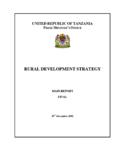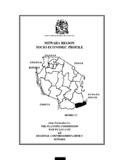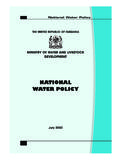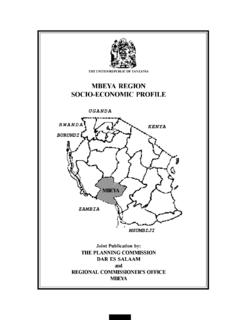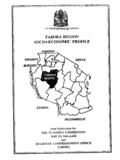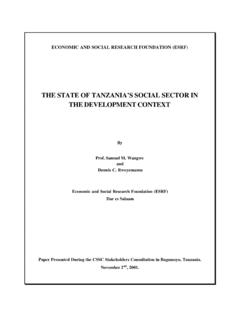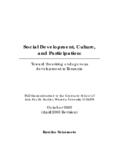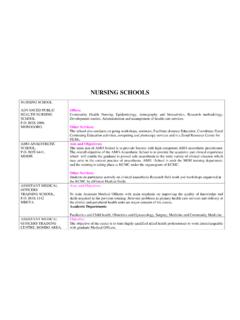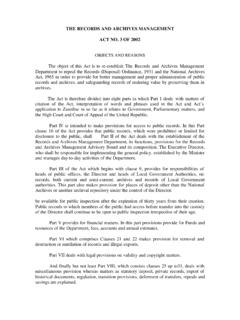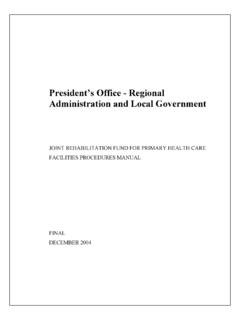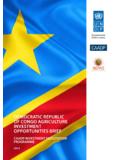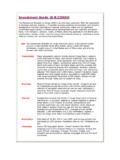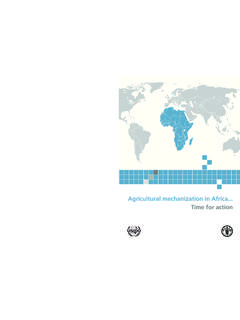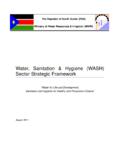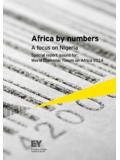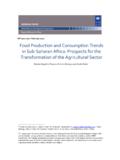Transcription of T MANUFACTURING SECTOR IN TANZANIA - Tzonline
1 1 THE MANUFACTURING SECTOR IN TANZANIA Final Report A study by the Confederation of TANZANIA Industries (CTI) and the Confederation of Danish Industries (DI) Sponsored by DANIDA 2 THE MANUFACTURING SECTOR IN TANZANIA A study by the Confederation of TANZANIA Industries (CTI) and the Confederation of Danish Industries (DI) in association with Dr. A. V. Y. Mbelle of the Economics Department, University of Dar es Salaam. December 2000 3 ACKNOWLEDGEMENTS In accomplishing this study we benefited from many people/institutions. Space does not allow us to mention all of them. We therefore take this opportunity to express our sincere gratitude to all of them. However, CTI and DI would like to thank DANIDA, without whose support this document would not have been possible.
2 We would also like to thank the 248 companies that responded to our questionnaire for this study. We would also like to acknowledge the contribution of: Dr. A. V. Y. Mbelle, for doing the data capture and processing; BRELA for providing us with a comprehensive list of MANUFACTURING establishments; and National Bureau of Statistics for its assistance in providing some of the macro-economic data. 1 Table of Content 1. 2. TANZANIA in General Population and Political History (Pre/post Independence)..5 Constitution and Political International The Gross Domestic Product (GDP)..9 Labour Key Inflation, Money Supply and Interest Foreign 3.
3 The MANUFACTURING SECTOR and the National MANUFACTURING and Foreign 4. The MANUFACTURING SECTOR Broad Sectoral Size and Composition of the MANUFACTURING Ownership Company Success Rate and Domestic Competition and Constraining Government Constraining Social Summary and Ranking of Broad Sectoral 5. The MANUFACTURING SECTOR Sub-sectoral Food Products (ISIC 311/2)..44 Beverages (ISIC 313)..45 Textiles (ISIC 321)..46 Wood Products Except Furniture (ISIC 331)..47 Paper and Paper Products (341)..48 Other Chemicals (ISIC 352)..49 Rubber products (ISIC 355)..50 Iron and Steel (ISIC 371)..51 Fabricated Metal Products (ISIC 381).
4 52 Summary and Ranking of Sub-sectoral 6. TANZANIA in a Comparative The MANUFACTURING SECTOR in a Regional Key Comparative Regional MANUFACTURING Intra Regional 2 Regional Global Value-added in Global Structure of MANUFACTURING TANZANIA in Trade The SADC and Annex A MANUFACTURING Survey Annex B Standard Industrial 3 1. Introduction Fragility and inefficiency have long characterized TANZANIA s MANUFACTURING SECTOR . In previous times the problems were predominantly related to government failures in developing an economy on the basis of a centrally planned structure. In recent years the main problems have been related to adjusting not only the MANUFACTURING SECTOR but the whole Tanzanian economy to the fierce demands of globalization.
5 The challenge has hence mainly been affiliated with creating an enabling environment for the productive sectors in the economy, most notably the MANUFACTURING SECTOR , in order to expand TANZANIA s present low level of competitiveness. This study is looking into the current process by examining important aspects concerning the recent developments in TANZANIA s MANUFACTURING SECTOR . The aim is to add to the existing knowledge base regarding current aspects of MANUFACTURING in TANZANIA such as size and composition of the SECTOR , company performance, employment development, and external constraining impact on the SECTOR . The study has been conducted in collaboration between the Confederation of Tanzanian Industries (CTI) and its sister organization in Denmark, the Confederation of Danish Industries (DI) and funded by DANIDA.
6 A major component of the exercise entailed carrying out a detailed survey. The results of the survey have and will be used for two purposes. Firstly, the data was processed for appliance in the report. Secondly, the data is to form the basic material for a database for use by the Confederation of Tanzanian Industries, who will be responsible for updating and expanding the data in the future. The report consists of six chapters. The first chapter is the introduction presented here. Chapter Two is a short description of the main characteristics of TANZANIA s society. It offers information about population, resources, history, political background and economic development.
7 Chapter Three is a description of the MANUFACTURING SECTOR in the context of the national economy. It looks into MANUFACTURING s contribution to key areas in the economy such as GDP, investment, employment, and foreign trade. Chapter Four and Five present the survey findings. The issues examined are size and composition, ownership structure, employment pattern, company performance, foreign trade, investment, and competitiveness. Chapter Four entails the survey results on a broad SECTOR level. Chapter Five evaluates the findings on specific industries. Chapter Six sets the condition of TANZANIA s MANUFACTURING SECTOR in a comparative context. The main indicators of the SECTOR are compared on an international level, from a regional and global perspective.
8 4 2. TANZANIA in General Terms Background TANZANIA is located in the eastern part of Africa between Mozambique and Kenya. It is bordered by Rwanda, Kenya, Uganda, Malawi, Burundi, and democratic republic of Congo. Climate conditions vary from tropical along the coastal region to temperate in the highlands. The country is gifted with a broad range of valuable natural resources, including gold, gemstones, diamonds, coal, phosphate, natural gas, nickel etc. It has also significant hydropower potential. The 945,087 km2 of the United republic of TANZANIA (incorporating mainland Tanganyika and a number of offshore islands, including Zanzibar, Pemba, Latham, and Mafia) have a wide variety of landforms and people.
9 The country includes the highest and lowest points in Africa with the summit of Mount Kilimanjaro (5,895 m above sea level) and the floor of Lake Tanganyika (358 m below sea level). With the exception of the high mountain areas, temperatures in TANZANIA are not a major limiting factor for crop growth, although the range of altitude produces a corresponding range of temperature regimes from tropical to temperate. Rainfall is variable, geographically as well as in time, and is generally lower than might be expected for the latitude. The most fertile soils in TANZANIA are the reddish-brown soils derived from the volcanic rocks, although elsewhere mbuga and other alluvial soils have good potential.
10 The interior plateaus are covered with tropical looms of moderate fertility. The natural vegetation of the country has been considerably modified by human occupation. In the south and west-central areas there are large tracts of woodland covering about 30 percent of the country, while on the uplands small but important areas of tropical rain forest can be found. Clearly marked latitudinal variations in vegetation occur around the upland areas and some distinctive mountain flora is found. TANZANIA has set aside about one-third of its land for national parks and game and forest reserves. Population and Resources The population of TANZANIA is estimated at 31 million with a growth rate of percent per annum.
